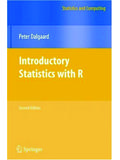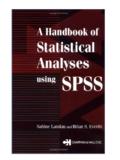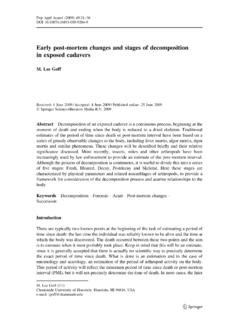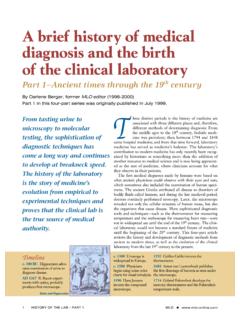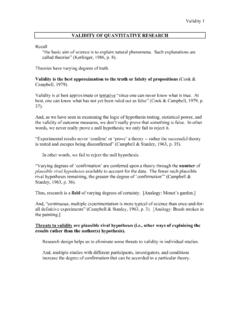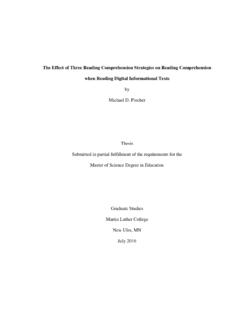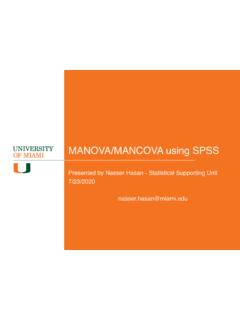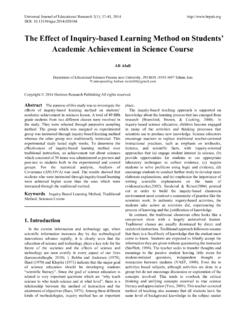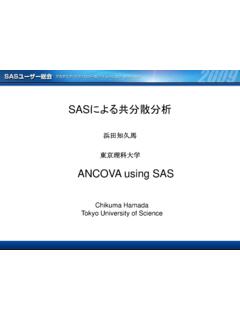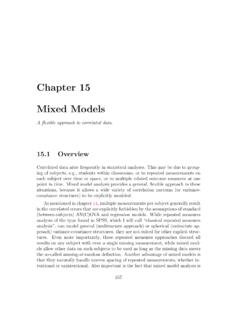Transcription of SPSS Survival Manual 2nd Edition - Academia.dk
1 spss Survival MANUALFor the spss Survival Manual website, go 7/12/04 4:30 PM Page i Bookhouse To any student who have found themselvesfacing the horror of spss after signing up for adegree in psychology this is a godsend. PSYCHOLOGY STUDENT, IRELAND This book really lives up to its name ..I highly recommend this book to any MBAstudent carrying out a dissertation project, oranyone who needs some basic help with usingSPSS and data analysis techniques. BUSINESS STUDENT, UK If the mere thought of statistics gives you aheadache, then this book is for you. STATISTICS STUDENT, UK .. one of the most useful, functional pieces ofinstruction I have seen.
2 So gold stars andthanks. INSTRUCTIONAL DESIGNER, USA .. being an external student so much of mytime is spent teaching myself. But this has beenmade easier with your Manual as I have foundmuch of the content very easy to follow. I onlywish I had discovered it earlier. ANTHROPOLOGY STUDENT, AUSTRALIA The strength of this book lies in theexplanations that accompany the descriptionsof tests and I predict great popularity for thistext among teachers, lecturers and researchers. ROGERWATSON, JOURNAL OFADVANCEDNURSING, 2001 .. an excellent book on both using spss andstatistical know how. LECTURER INBUSINESSRESEARCHMETHODS, UK spss Survival Manualwas the only oneamong loads of spss books in the library thatwas so detailed and easy to follow.
3 DOCTORAL STUDENT INEDUCATION, UK My students have sung the book s statistics, I usually don t get muchpraise from students for any book. STATISTICS LECTURER, USA Truly the best spss book on the market. LECTURER INMANAGEMENT, AUSTRALIA I was behind in class, I was not getting it and I was desperate! So I bought all the spss books I could find. This book is the one I I needed to know and be able to dowas clearly explained. The accompanyingonline database served as an example, showingme how to enter data. This book will not goon my bookshelf; it will remain on my deskthrough my dissertation and afterwards.
4 STUDENT, USA This book is exactly what it claims to be a Survival Manual . It contains step by stepinstructions and clear explanations of how touse spss , how to interpret the results, andselecting appropriate tests. This isn t a statisticsprimer or a text on research design. This is abook for those who haven t had five statscourses and years of using spss . If you needhelp using spss to evaluate research data get this book. A lifesaver! STUDENT, USA I like it very much and I find it very usefel. SOCIOLOGY STUDENT, CZECHREPUBLICThis is what readers from around the world say about the spss Survival 7/12/04 4:30 PM Page ii Bookhouse spss Survival MANUALA step by step guide to data analysis usingSPSS for Windows (Version 12)JULIE 7/12/04 4:30 PM Page iii Bookhouse First published in 2002 This Edition published in 2005 Copyright Julie Pallant 2002, 2005 All rights reserved.
5 No part of this book may be reproduced ortransmitted in any form or by any means, electronic or mechanical,including photocopying, recording or by any information storageand retrieval system, without prior permission in writing from thepublisher. The Australian Copyright Act 1968 (the Act) allows amaximum of one chapter or 10 per cent of this book, whicheveris the greater, to be photocopied by any educational institution forits educational purposes provided that the educational institution(or body that administers it) has given a remuneration notice toCopyright Agency Limited (CAL) under the & Unwin83 Alexander StreetCrows Nest NSW 2065 AustraliaPhone: (61 2) 8425 0100 Fax:(61 2) 9906 Library of AustraliaCataloguing-in-Publication entry:Pallant, Julie F.
6 (Julie Florence), 1961- . spss Survival Manual : a step by step guide to dataanalysis using 1 74114 478 Social sciences Statistical methods Computerprograms. I. in pt Sabon by Bookhouse, SydneyPrinted by Ligare, Sydney10 9 8 7 6 5 4 3 2 7/12/04 4:30 PM Page iv Bookhouse ContentsContentsData files and websitexiIntroduction and overviewxiiStructure of this bookxiiiUsing this bookxiiiResearch tipsxvAdditional resourcesxviPARTONEG etting started11 Designing a study3 Planning the study3 Choosing appropriate scales and measures5 Preparing a questionnaire7 References102 Preparing a codebook12 Variable names12 Coding responses14 Coding open-ended questions143 Getting to know SPSS16 Starting SPSS16 Opening an existing data file16 Working with data files17 spss windows18 Menus22 Dialogue boxes22 Closing SPSS24 Getting help24 PARTTWOP reparing the data file254
7 Creating a data file and entering data27 Changing the spss Options 27 Defining the variables30 Entering data34 Modifying the data file35 Data entry using 7/12/04 4:30 PM Page v Bookhouse 5 Screening and cleaning the data40 Step 1: Checking for errors40 Step 2: Finding the error in the data file43 Step 3: Correcting the error in the data file45 Reference46 PARTTHREEP reliminary analyses476 Descriptive statistics49 Categorical variables49 Continuous variables50 Assessing normality53 Checking for outliers58 Additional exercises62 References637 Using graphs to describe and explore the data64 Histograms64 Bar graphs66 Scatterplots68 Boxplots70 Line graphs72 Editing a chart/graph74 Importing charts/graphs into Word documents75 Additional exercises768 Manipulating the data78 Calculating total scale scores78 Transforming variables82 Collapsing a continuous variable into groups85 Collapsing the number of categories of
8 A categorical variable86 Additional exercises88 Reference899 Checking the reliability of a scale90 Details of example90 Interpreting the output from reliability92 Presenting the results from reliability92 Additional exercises93 References93 spss Survival 7/12/04 4:30 PM Page vi Bookhouse 10 Choosing the right statistic94 Overview of the different statistical techniques94 The decision-making process98 Key features of the major statistical techniques104 References109 Summary table of the characteristics of the main statisticaltechniques110 PARTFOURS tatistical techniques to explore relationships among variables113 Techniques covered in Part Four113 Revision of the basics114 References11911 Correlation121 Details of example122 Preliminary analyses for correlation123 Interpretation of output from correlation125 Presenting the results from correlation127 Obtaining
9 Correlation coefficients between groups of variables128 Comparing the correlation coefficients for two groups130 Testing the statistical significance of the difference betweencorrelation coefficients132 Additional exercises135 Reference13512 Partial correlation136 Details of example136 Interpretation of output from partial correlation138 Presenting the results from partial correlation139 Additional exercises139 References13913 Multiple regression140 Major types of multiple regression141 Assumptions of multiple regression142 Details of example144 Standard multiple regression146 Hierarchical multiple regression155 Interpretation of output from hierarchical multiple regression157 Presenting the results from multiple regression158 Additional 7/12/04 4:30 PM Page vii Bookhouse 14 Logistic regression160 Assumptions161 Details of example162 Data preparation.
10 Coding of responses162 Interpretion of output from logistic regression166 Presenting the results from logistic regression170 References17115 Factor analysis172 Steps involved in factor analysis173 Details of example177 Procedure for factor analysis178 Warning190 Presenting the results from factor analysis190 Additional exercises192 References193 PARTFIVES tatistical techniques to compare groups195 Techniques covered in Part Five195 Assumptions196 Type 1 error, Type 2 error and power198 Planned comparisons/Post-hoc analyses199 Effect size201 References20316T-tests205 Independent-samples t-test205 Paired-samples t-test209 Additional exercises213 Reference21317 One-way analysis of variance214 One-way between-groups ANOVA with post-hoc tests215 One-way between-groups ANOVA with planned comparisons220 One-way repeated measures ANOVA223 Additional exercises227 References22818 Two-way between-groups ANOVA229 Details of example229 Interpretation of output from two-way ANOVA233 Presenting the results from two-way ANOVA236 Additional analyses if you obtain asignificant
